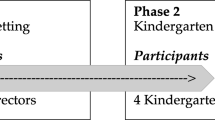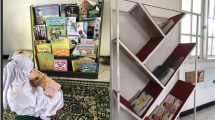Abstract
That an educator should read texts aloud to children is a cornerstone of literacy pedagogy. And although it is well established that reading aloud to children occurs frequently across educational contexts, less clear is the ways those unique contexts shape the text choices, teaching strategies and expectations for children’s engagement with these literacy learning experiences. The findings shared in this paper sit within a larger study examining the changing literacy demands for learners across their schooling years. The paper examines the literacy learning demands during acts of reading aloud as they were offered in two pre-school settings (prior-to-school) and two Kindergarten classrooms (the first year of formal primary schooling). Analyses of classroom observations and teacher semi-structured interview transcripts through the interactions, the time structures, the use of space and of resources illustrate Bernstein’s theory of visible and invisible literacy learning pedagogies evident in these representations of reading aloud. Considered in the paper are implications for children when pedagogical decisions constrain and enable early literacy learning. The paper contributes to existing understandings about early literacy learning by arguing for greater clarity in the ways the teaching of reading is positioned and articulated for children.
Similar content being viewed by others
References
Australian Curriculum, Assessment and Reporting Authority (ACARA). (2014). Foundation to year 10 curriculum. Canberra, ACT: Commonwealth of Australia. http://www.australiancurriculum.edu.au/english/curriculum /f-10?layout=1#…
Barter, C. & Renold, E. (2000) ‘I wanna tell you a story’: Exploring the application of vignettes in qualitative research with children and young people. International Journal of Social Research Methodology, 3 (4), 307–323, DOI: 10.1080/13645570050178594
Bennett, S.V., Gunn, A.A., Gayle-Evans, G., Barrera, E.S. & Leung, C.B. (2017). Culturally responsive literacy practices in an early childhood community. Early Childhood Education Journal, 1–8.
Bernstein, B. (1975). Class and pedagogies: Visible and invisible. Educational Studies, 1 (1), 23–41.
Bernstein, B. (1996). Pedagogy, symbolic control and identity: Theory, research and critique. London: Taylor & Francis.
Burkins, J.M. & Croft, M.M. (2010). Preventing misguided reading: New strategies for guided reading teachers. International Reading Association. Newark, DE.
Chall, J. (1983). Stages of reading development. New York: McGraw Hill Book Company.
Clay, M.M. (1991). Becoming literate: The construction of inner control. Heinemann Educational Books.
Copeland, S.R. & Keefe, E.B. (2016). Teaching reading and literacy skills to students with intellectual disability. Handbook of Research-Based Practices for Educating Students with Intellectual Disability, 320.
Department of Education Employment and Workplace Relations (DEEWR). (2009). Belonging, being and becoming: The early years learning framework for Australia. Canberra, ACT: Commonwealth of Australia.
Edwards Santoro, L., Chard, D.J., Howard, L. & Baker, S.K. (2008). Making the very most of classroom read-alouds. The Reading Teacher, 61 (5), 396–408. DOI:10.1598/RT.61.5.4
Fisher, D., Flood, J., Lapp, D. & Frey, N. (2004). Interactive read-alouds: Is there a common set of implementation practices? The Reading Teacher, 58 (1), 8–17. DOI:10.1598/RT.58.11
Fleer, M. (2013). Play in the early years. New York, NY: Cambridge University Press.
Fountas, I.C. & Pinnell, G.S. (2006). Teaching for comprehending and fuency: Thinking, talking, and writing about reading, K–8. Heinemann Educational Books.
Goouch, K. (2008). Understanding playful pedagogies, play narratives and play spaces, Early Years, 28 (1), 93–102. DOI: 10.1080/09575140701815136
Hill, S. (2004). Privileged literacy in preschool. The Australian Journal of Language and Literacy, 27 (2), 159.
Johnston, V. (2016). Successful read-alouds in today’s classroom. Kappa Delta Pi Record, 52 (1), 39–42.
Kervin, L. & Verenikina, I. (2017). Children at play: digital resources in home and school contexts. In G. Goodliff, N. Canning, J. Parry & L. Miller (Eds.), Young children’s play and creativity: Multiple oices (pp. 99–112). NY: Routledge Taylor & Francis.
Kervin, L., Turbill, J. & Harden-Thew, K. (2017). Invisible to visible: Mapping the continuum of literacy learning experiences in an early years setting. Journal of Early Childhood Literacy, 17 (4), 465–484, DOI 1468798416638139.
Lightner, S.C. & Wilkinson, I.A. (2017). Instructional frameworks for quality talk about text: Choosing the best approach. The Reading Teacher, 70 (4), 435–444.
Martinez, M.G. & Teale, H.G. (1993). Teacher storybook reading style: A comparison of six teachers. Research in the Teaching of English, 27 (2), 175–199.
Massaro, D.W. (2017). Reading aloud to children: Benefts and implications for acquiring literacy before schooling begins. American Journal of Psychology, 130 (1), 63–72.
McGee, L.M. & Schickedanz, J.A. (2007). Repeated interactive read-alouds in preschool and kindergarten. The Reading Teacher, 60 (8), 742–751.
Paris, S.G. & Luo, S.W. (2010). Confounded statistical analyses hinder interpretation of the NELP Report. Educational Researcher, 39 (4), 316–322.
Rog, L.J. (2001). Early literacy instruction in Kindergarten. International Reading Association, Newark, DE.
Rogers, R., Labadie, M. & Pole, K. (2016). Balancing voice and protection in literacy studies with young children. Journal of Early Childhood Literacy, 16 (1), 34–59.
Roskos, K.A., Christie, J.F., Widman, S. & Holding, A. (2010). Three decades in: Priming for meta-analysis in play-literacy research. Journal of Early Childhood Literacy, 10 (1), 55–96.
Schleppegrell, M. (2008) The language of schooling. Taylor and Frances: Mahwah, New Jersey.
Seven, S. (2010). Attachment and social behaviors in the period of transition from preschool to frst grade. Social Behavior and Personality, 38 (3): 347–356.
Stephen, C. (2010). Pedagogy: The silent partner in early years learning, Early Years, 30 (1), 15–28, DOI: 10.1080/09575140903402881
Turunen, T. (2014). Experienced and recalled transition: Starting school as part of life history. In B. Perry, S. Dockett & A. Petriwskyj (Eds.), Transitions to school–international research policy and practice. Dordrecht: Springer.
Walsh, R.L. & Hodge, K.A. (2016). Are we asking the right questions? An analysis of research on the effect of teachers’ questioning on children’s language during shared book reading with young children. Journal of Early Childhood Literacy, 0 (0), 1–31. DOI:10.1177/1468798416659124
Wright, T.S. & Cervetti, G.N. (2017). A systematic review of the research on vocabulary instruction that impacts text comprehension. Reading Research Quarterly, 52 (2), 203–226.
Xue, Y. & Meisels, S.J. (2004). Early literacy instruction and learning in Kindergarten: Evidence from the Early Childhood Longitudinal Study–Kindergarten class of 1998–1999. American Educational Research Journal, 41 (1), 191–229.
Literature cited
Amery, H. & Cartwright, S. (2004). The new pony. Usborne First Reading. London, UK, Usborne Publishing Ltd.
Ross, C. (1997). In a dark, dark, wood. The Story Box. Wright Group/Mcgraw-Hill.
Vaughan, M.K. & Lofts, P. (1984). Wombat stew. Sydney: Ashton Scholastic.
Author information
Authors and Affiliations
Rights and permissions
About this article
Cite this article
Mantei, J., Kervin, L. Examining literacy demands for children during teacher-led episodes of reading aloud across the transition from Preschool to Kindergarten. AJLL 41, 82–93 (2018). https://doi.org/10.1007/BF03652009
Published:
Issue Date:
DOI: https://doi.org/10.1007/BF03652009




